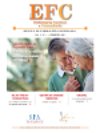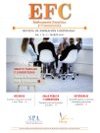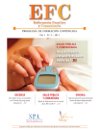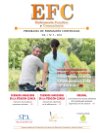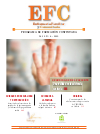EDITORIAL
Función Directiva
Jesús Sanz Villorejo
Presidente de ANDE
Uno de los aspectos fundamentales de la Función Directiva es la toma de decisiones que afectan a otras personas, y cualquier decisión se adopta siempre partiendo de unos valores determinados. En toda decisión, incluso en la más sencilla, se incluyen los valores. Y son esos valores los que delimitan el escenario de actuación de las personas [...]
COMPETENCIAS ENFERMERAS
CUIDADOS EN SEXUALIDAD Y REPRODUCCIÓN
Atención de enfermería en los períodos de la perimenopausia y el síndrome de hipogonadismo tardío.
Nursing care in perimenopuse and late-onset hypogonadism.
María Dolores Calle Calle.
El periodo de la perimenopausia y el hipogonadismo de inicio tardío (HIT) son etapas de transición en la vida del hombre y de la mujer caracterizadas por cambios físicos, sexuales, psicológicos y sociales. Estos cambios frecuentemente son vividos de manera negativa dado que se asocian a los mitos que rodean al proceso de envejecimiento. El objetivo de este artículo es contribuir a ampliar el conocimiento sobre la perimenopausia y el HIT con el fin de que la enfermera sea capaz de fomentar el autoconocimiento, afrontamiento y autocuidado ante los cambios más frecuentes en la dimensión sexual que se producen en este periodo de la vida. Para ello, se explican los conceptos en torno a la dimensión sexual desde el marco que nos ofrece la Sexología y que permiten entender el Hecho Sexual Humano (HSH) como un proceso biográfico. A la vez que se comentará la influencia de los cambios de esta etapa de la vida en el HSH y más concretamente en sus cuatro registros, el sexo, la sexualidad, la erótica y la amatoria. Por último, se ofrecen claves para abordar el cuidado enfermero de las personas en esta etapa de la vida.
Palabras clave: Perimenopausia, menopausia, hipogonadismo de inicio tardío, hecho sexual humano, sexualidad, cuidado enfermero.
The period of perimenopause and late-onset hypogonadism (LOH) are stages of transition in the life of the man and woman characterized by physical, sexual, psychological, and social changes. These changes are often experienced negatively because that is associated with the myths surrounding the process of aging. The aim of this article is to help expand knowledge about perimenopause and late hypogonadism syndrome with the purpose that the nurse is able to promote self-knowledge, coping and self-care faced with the more frequent changes in the sexual dimension in this period of life. To do this, explains the concepts around the sexual dimension from the framework provided us the Sexology, that allows to understand the Human Sexual Being (HSB) as a biographical process. At the same time that we will discuss the influence of the changes of this stage of life in the HSB and more specifically in its four fields, sex, sexuality, the erotic and the amatoria. Finally, keys are available to address the care nurse of the people at this stage of life.
Keywords: perimenopause, menopause, late-onset hypogonadism, human sexual being, sexuality, nursing care.
CUIDADOS A LA FAMILIA
Cuidados enfermeros a la familia desde un enfoque sistémico.
Nursing care to the family from a systemic approach
Mª Dolores Mirón Ortega.
La tensión y el cambio forman parte del funcionamiento normal de una familia. Cuando existen dificultades de afrontamiento ante situaciones estresantes, y las necesidades de sus miembros están constantemente insatisfechas, el funcionamiento de la familia se resiente. El grado de funcionalidad de una familia vendrá dado por su capacidad para mantener un equilibrio entre la tendencia al cambio y la tendencia a la homeostasis. Así, una familia funcional será capaz de adaptarse a los cambios necesarios a lo largo del proceso vital: crecimiento y envejecimiento; incorporación y pérdida de miembros de la familia; oscilaciones en el estado de salud; el estrés ambiental. Y una familia disfuncional será aquella incapaz de responder a las necesidades de sus miembros y de afrontar con éxito los cambios y tensiones de su entorno. Conocer los ciclos de la vida, tanto el individual como el familiar, nos permite predecir las crisis normativas e intervenir anticipadamente en las accidentales, antes de que aparezca la disfunción familiar.
Palabras clave: Terapia familiar, enfermería comunitaria, cuidado.
The Stress and change are part of the normal operation of a family. When there are difficulties of coping with stressful situations and needs of its members are constantly unsatisfied, the operation of the family suffers. The degree of functionality of a family will be given by its ability to maintain a balance between the trend and the trend change homeostasis. Thus, the functional family will be able to adapt to the necessary changes throughout the life process: growth and aging; incorporation and loss of family members; oscillations in the health, environmental stress. And a dysfunctional family that is unable to meet the needs of its members and to successfully meet the changes and stresses of their environment. Knowing the cycles of life, both individual and the family, allows us to predict crises and intervene early regulations and accident, before the appearance of family dysfunction.
Keywords: Family therapy, community health nursing, care.
GESTIÓN ENFERMERA EN ATENCIÓN PRIMARIA
Seguridad en el paciente. Una realidad en la asistencia sanitaria.
Patient safety. A reality in healthcare.
Oscar Aguado Arroyo. Higinio Pensado Freire. Verónica Moreno Esquiliche.
La seguridad del paciente es un factor esencial de calidad asistencial y desde la publicación del informe "Errar es humano", es objetivo prioritario y por tanto, requiere la implicación de todas las categorías profesionales y un abordaje global y multidisciplinar. Las estrategias de mejora han estimulado el desarrollo de modelos que permiten un mejor conocimiento de los efectos adversos ligados a la asistencia sanitaria. Los sistemas de comunicación de efectos adversos generan información que permitirá adoptar medidas que incrementen la calidad asistencial. Los efectos adversos más comunes son los relacionados con el uso de medicamentos y con frecuencia son evitables. La cultura de seguridad se define como el conjunto de valores, actitudes y comportamientos predominantes que caracterizan el funcionamiento del grupo o una organización. Conseguir cambiar la cultura de ocultación de los errores o de simple reacción frente a los efectos adversos por otra, en la que los errores no sean considera dos fallos personales, sino consecuencia de la interacción de múltiples factores y oportunidades para mejorar el sistema y evitar el daño, es el primer paso para mejorar la seguridad del paciente. Lo más importante cuando surge un problema no es ¿Quién? sino ¿Qué ocurrió?, ¿Cómo?, ¿Cuándo?, ¿Por qué?, ¿Cómo se podría haber evitado? y ¿Qué puede hacerse para que no vuelva a ocurrir?
Gestionar el riesgo de la práctica clínica supone disminuir, detectar y mitigar los sucesos adversos cuando se producen, empleando estrategias dirigidas a reducir la complejidad, optimizar la información y la automatización de procesos.
Palabras clave: Seguridad del paciente. Efectos Colaterales y Reacciones Adversas Relacionados con Medicamentos. Gestión de la seguridad.
Patient safety is a key factor in quality of care and since the publication of the report "To Err is Human" Patient safety is the priority objective and therefore requires the involvement of all occupational categories and an overall approach and multidisciplinar. Las improvement strategies have stimulated the development of models that allow a better understanding of the adverse effects associated with healthcare. Communication systems of adverse generate information that action can be taken to increase the quality of care. The most common adverse effects are related to drug use and are often preventable. Safety culture is defined as the set of values, prevailing attitudes and behaviors that characterize the functioning of the group or organization. Getting changing the culture of concealment of errors or simple reaction against adverse effects on the other, where the errors are not considered personal failures, but the consequence of the interaction of multiple factors and opportunities to improve the system and prevent damage , is the first step to improving patient safety. The most important thing when a problem arises is not "Who?" But "What happened", "How", "When?", "Why?", "How could have been avoided?" And "What can be done so that does not happen again?"
Managing risk in clinical practice involves decreasing, detect and mitigate the adverse events when they occur, using strategies to reduce complexity, improve information and process automation.
Keywords: Patient safety. Drug-Related Side Effects and Adverse Reactions, Safety Management.
ORIGINAL
ATENCIÓN A LA SALUD PÚBLICA
Conocimientos de los adolescentes sobre prevención del VIH/SIDA en Galicia.
Knowledge of Galician Youth about HIV prevention
Eva Tizón Bouza, Alma María San Isidro Morado, Miriam Paula Marcos Espino, Damián García Rodríguez, Marta Porto Esteiro, Zoraida Rodríguez Soto.
Objetivo: Conocer el nivel de conocimientos de los adolescentes gallegos en prevención del VIH/SIDA.
Metodología: Estudio descriptivo transversal, con cuestionario ad hoc de 96 variables, aplicado a adolescentes de Galicia (entre junio diciembre de 2010), previo a las intervenciones educativas del programa GALIA.
Resultados: Se obtienen 256 cuestionarios cuyo perfil es una mujer heterosexual, de entre 14 y 16 años, con vida sexual activa. Un 66% afirma no haber estado expuesto al VIH. Un 85% tiene información sobre VIH, principalmente de los profesores.
Conclusión: Los jóvenes tienen información acerca de VIH, pero frecuentemente presentan prácticas de riesgo. Es necesario seguir reforzando conocimientos a través de las intervenciones educativas en aquellas áreas más deficitarias.
Palabras clave: Prevención, VIH/SIDA, preservativo, adolescentes.
Objective: To determinate the level of knowledge of Galician youth about HIV/AIDS.
Methods: Descriptive study with a questionnaire of 96 variables, applied to young people of Galicia (from June to December 2010), before educational program.
Results: 256 questionnaires were obtained whose profile was a heterosexual girl, aged 14-16, sexually active. Some 66% say they have been possible exposed to HIV. 85% have information on HIV, mainly of teachers.
Conclusions: Young people know about HIV, but often have risky practices-. Knowledge needs to be strengthened through educational interventions in deficient areas.
Keywords: Prevention, HIV/AIDS, condom, youth.


